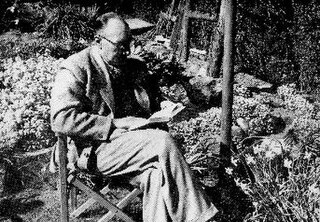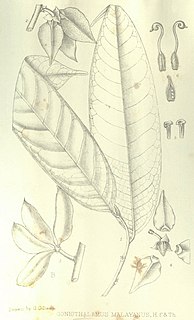Related Research Articles

The Singapore Botanic Gardens is a 163-year-old tropical garden located at the fringe of the Orchard Road shopping district in Singapore. It is one of three gardens, and the only tropical garden, to be honoured as a UNESCO World Heritage Site. The Botanic Gardens has been ranked Asia's top park attraction since 2013, by TripAdvisor Travellers' Choice Awards. It was declared the inaugural Garden of the Year, International Garden Tourism Awards in 2012.

Henry Nicholas Ridley CMG (1911), MA (Oxon), FRS, FLS, F.R.H.S. was an English botanist, geologist and naturalist who lived much of his life in Singapore. He was instrumental in promoting rubber trees in the Malay Peninsula and, for the fervour with which he pursued it, came to be known as "Mad Ridley".

Rafflesia arnoldii, the corpse flower or giant padma, is a species of flowering plant in the parasitic genus Rafflesia. It is noted for producing the largest individual flower on Earth. It has a strong and unpleasant odor of decaying flesh. It is native to the rainforests of Sumatra and Borneo. Although there are some plants with larger flowering organs like the titan arum and talipot palm, those are technically clusters of many flowers.
Edred John Henry Corner FRS was an English mycologist and botanist who occupied the posts of assistant director at the Singapore Botanic Gardens (1926–1946) and Professor of Tropical Botany at the University of Cambridge (1965–1973). Corner was a Fellow of Sidney Sussex College from 1959.

Professor David John Mabberley, is a British-born botanist, educator and writer. Among his varied scientific interests is the taxonomy of tropical plants, especially trees of the families Labiatae, Meliaceae and Rutaceae. He is perhaps best known for his plant dictionary The plant-book. A portable dictionary of the vascular plants. The third edition was published in 2008 as Mabberley's Plant-book, for which he was awarded the Engler Medal in Silver in 2009. As of June 2017 Mabberley's Plant-book is in its fourth edition.
Thomas Moore was a British gardener and botanist. An expert on ferns and fern allies from the British Isles, he served as Curator of the Society of Apothecaries Garden from 1848 to 1887. In 1855 he authored The Ferns of Great Britain and Ireland. The standard author abbreviation T.Moore is used to indicate this person as the author when citing a botanical name.
Tan Sri Datuk Michael Chang Min Tat was a Malaysian Federal Court judge, a Commissioner of Law Revision and Law Reform and chairman of the Penang State Planning Appeals Board, among other roles, and was acknowledged for his tremendous contributions to the development of the law in Malaysia.

Isaac Henry Burkill was an English botanist who worked in India and in the Straits Settlements. He worked primarily in economic botany but published extensively on plant biology, ethno-botany, insect-plant interactions and described several species. He published a two volume compilation on the plants of economic importance in the Malay Peninsula, collating local names and knowledge. He also wrote a detailed history of botany in India. The plant genera Burkillia and Burkillianthus were named in his honour.
Barbara Mary Steyning Everard was a botanical illustrator whose work encompassed books, private commissions, botanical publications, gardening magazines, greetings cards and commemorative plates.

Spathoglottis plicata, commonly known as the Philippine ground orchid, or large purple orchid is an evergreen, terrestrial plant with crowded pseudobulbs, three or four large, pleated leaves and up to forty resupinate, pink to purple flowers. It is found from tropical and subtropical Asia to Australia and the western Pacific including Tonga and Samoa.

Murray Ross Henderson (1899–1982) was a Scottish botanist who did most of his botanical work in the Straits Settlements and South Africa. He took a position as a botanist in Malaya in 1921 and became curator of the herbarium in the Singapore Botanical Gardens in 1924.
Warren Delabere Barnes was a British colonial administrator.
Wee-Lek Chew is a Singaporean-born botanist.
Betty Eleanor Gosset Molesworth Allen was a New Zealand botanist. She researched and published extensively on Southeast Asian ferns, and in her retirement she discovered a fern in southern Spain that had previously been thought to be an exclusively tropical species.

Dipteris conjugata is a species of fern. It has a rhizome, and 2-3 tall stems with mid green or dark green fronds, which have several divisions to toothed lobes. It is grows in clearings, mountain ridges and in forest margins, from tropical and temperate Asia, northern Queensland in Australia and some islands in the Pacific Ocean. It has limited native medicinal uses.
Cedric Errol Carr was a New Zealand botanist, specialising in orchids. At the age of seven he went to England with his family but from January 1913 until 1931, apart from military service from 1916 to 1918, he worked on rubber plantations in Malaya.

Goniothalamus malayanus is a species of plant in the family Annonaceae. It is native to Borneo, the Malay Peninsula, the Nicobar Islands, Sumatra and Thailand. Joseph Dalton Hooker and Thomas Thomson, the British botanists who first formally described the species, named it after part of its habitat range, British Malaya.
Caetano Xavier dos Remedios Furtado was a botanist who specialized in palms. He worked at the Singapore botanical gardens. He described nearly 104 species of palms, worked on the African genus Hyphaene and on the family Araceae. The species Maxburretia furtadoana was named after him by John Dransfield in 1978. He was also involved in clarifying the terms "illegitimate" and "superfluous" names in taxonomic nomenclature. He also coined the word "basinym" which was modified as basionym.
Burkill Hall is a historic bungalow in the Singapore Botanic Gardens. It is the last Anglo-Malayan plantation-style house in the region and possibly in the world.
Humphrey Morrison Burkill OBE, was a director of the Singapore Botanic Gardens from 1957-1969.
References
- 1 2 "Holttum, Richard Eric (1895-1990)". International Plant Name Index.
{{cite web}}: CS1 maint: url-status (link) - ↑ "Eric Holttum". The Times. Times Newspapers Limited. 25 September 1990. p. 14. Retrieved 10 May 2021.
- 1 2 3 4 5 6 7 8 9 Corfield, Justin (2010). Historical Dictionary of Singapore . Scarecrow Press. pp. 107–. ISBN 9780810873872.
- ↑ Bootham School Register. York, England: Bootham Old Scholars Association. 2011.
- ↑ "Richard Eric Holttum | Infopedia".
- 1 2 3 4 5 6 "The DNA of Singapore: R. E. Holttum". Raffles Museum on Biodiversity Research. Retrieved 30 May 2013.
- ↑ "A Brief History..." National University of Singapore . Retrieved 30 May 2013.
- ↑ McClintock, David (March 1976). "Professor Richard Eric Holttum, M.A., Sc.D., D.Sc., F.L.S. an appreciation". Biological Journal of the Linnean Society. 8: 1–23. doi:10.1111/j.1095-8312.1976.tb00231.x.
- ↑ Holttum, Richard E. (April 1975). "R.E. Holttum, by himself". Flora Malesiana Bulletin. 28: 2477–2500.
- ↑ "Myconet". Archived from the original on 18 March 2009. Retrieved 21 April 2009.
- ↑ Swallen, Jason Richard. 1964. Phytologia 11(3): 154
- ↑ The Plant List search for Holttumochloa
- ↑ Bulu Perindu Resources
- ↑ Stearn, William T (August 1991). "Richard Eric Holttum (1895-1990)". The Linnean. 7 (3): 12–18.